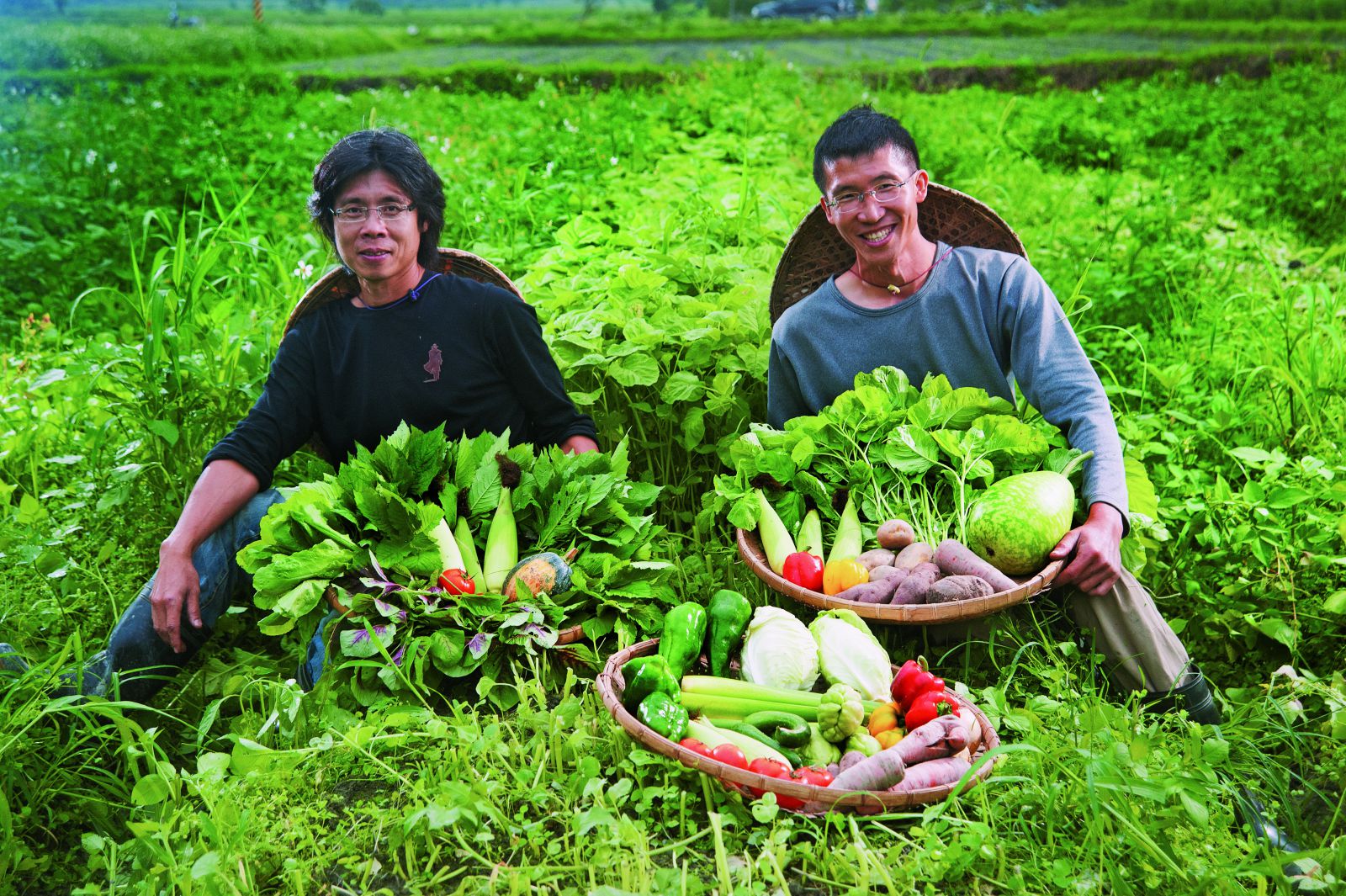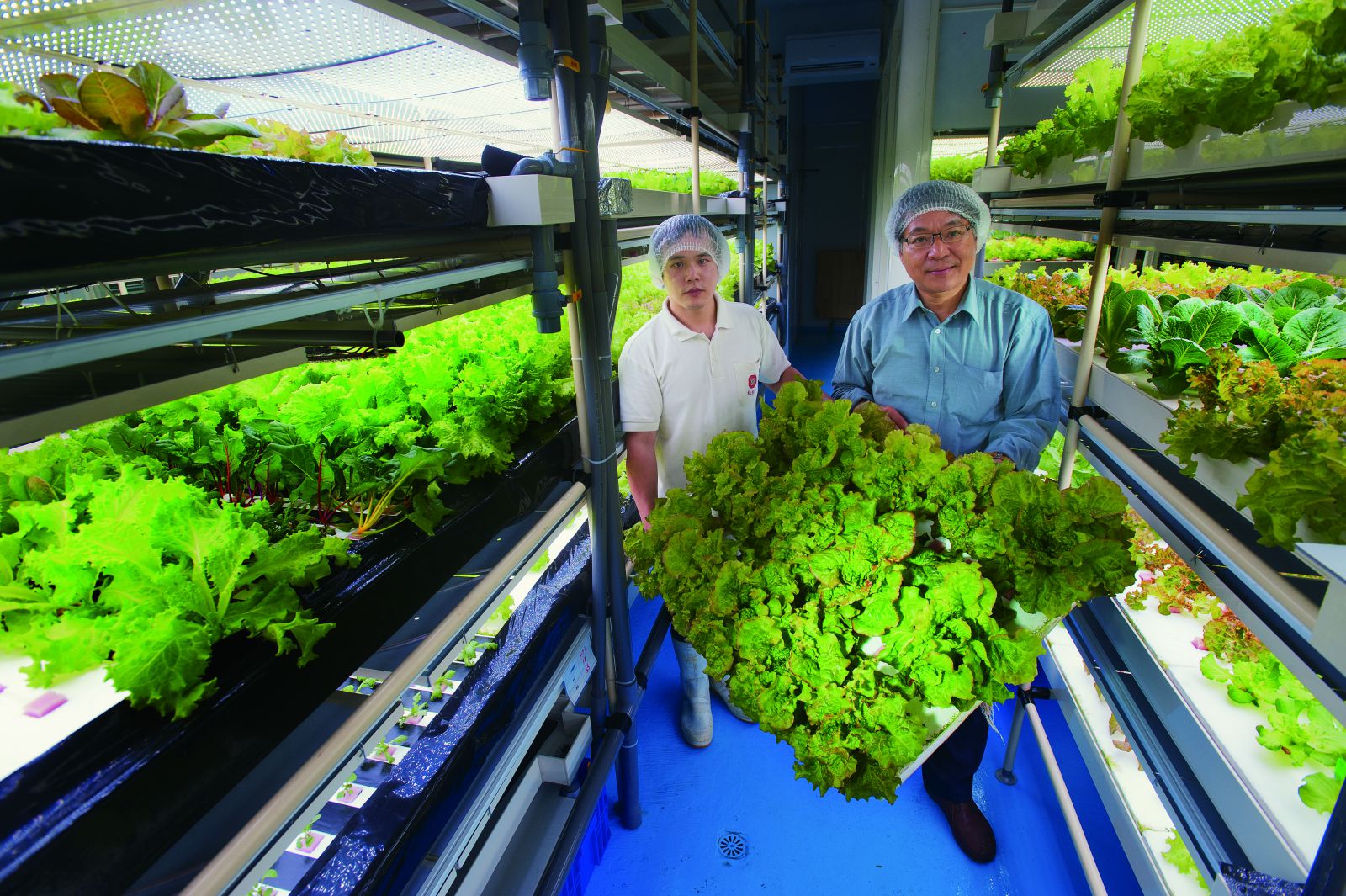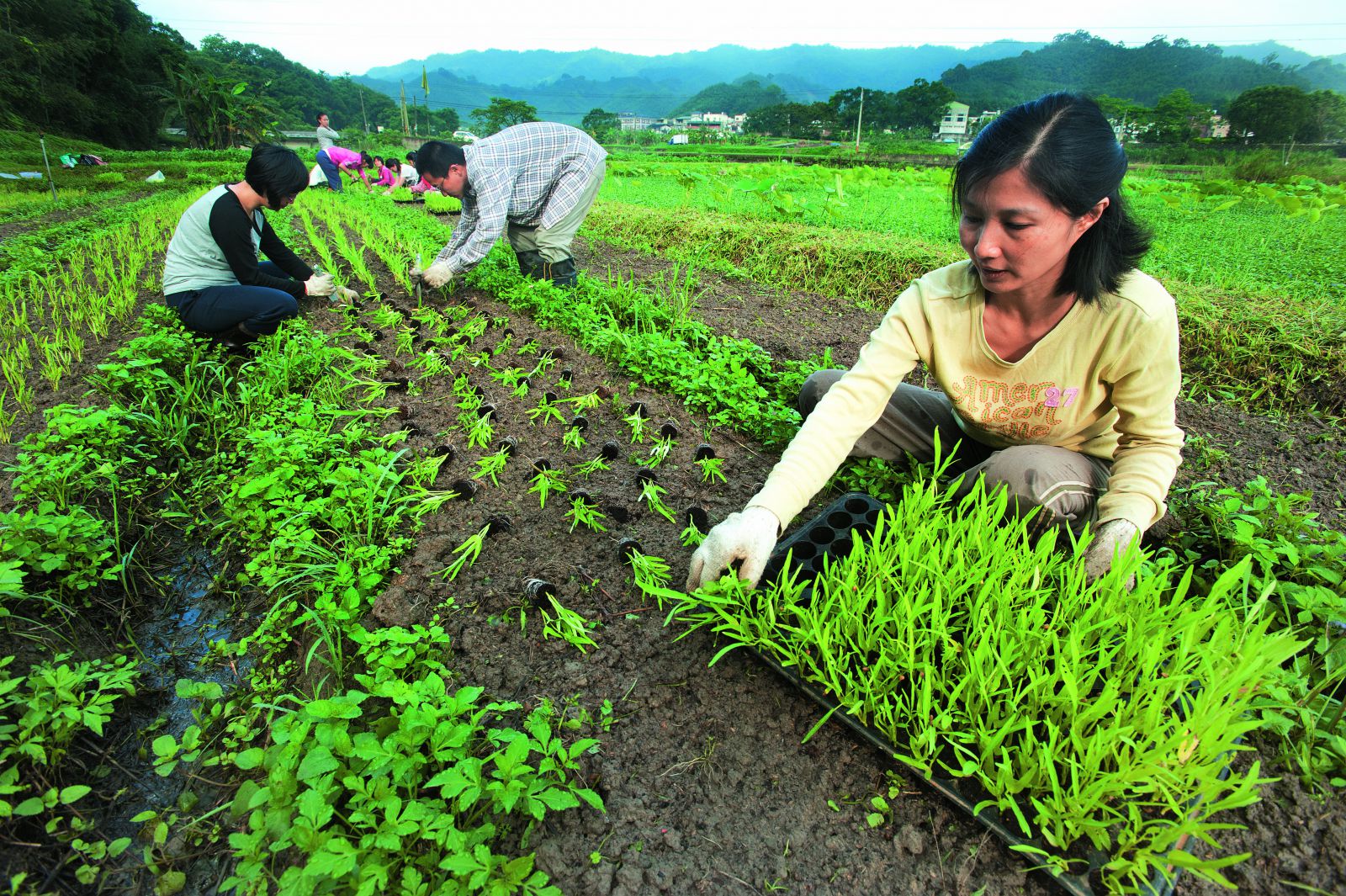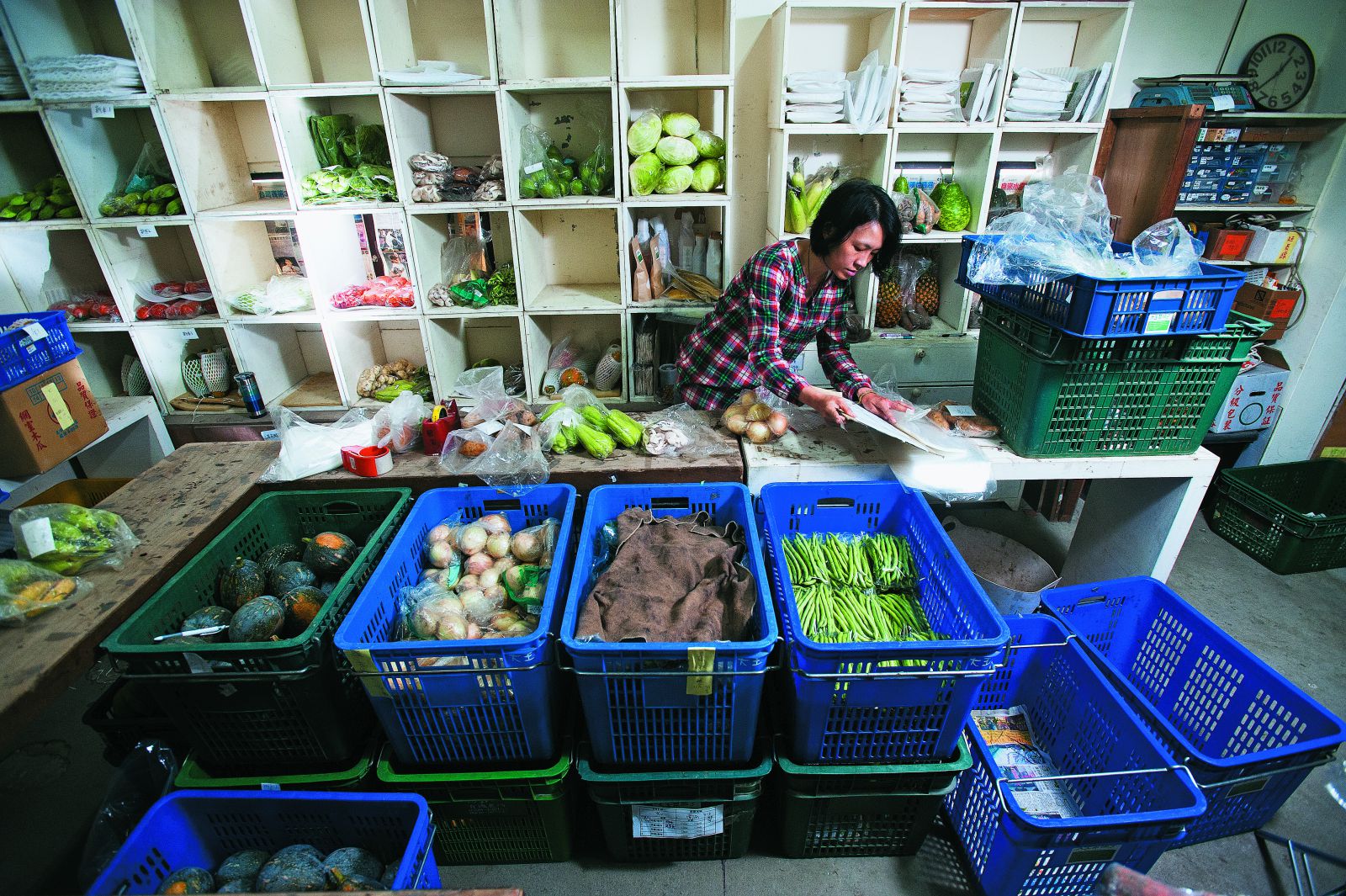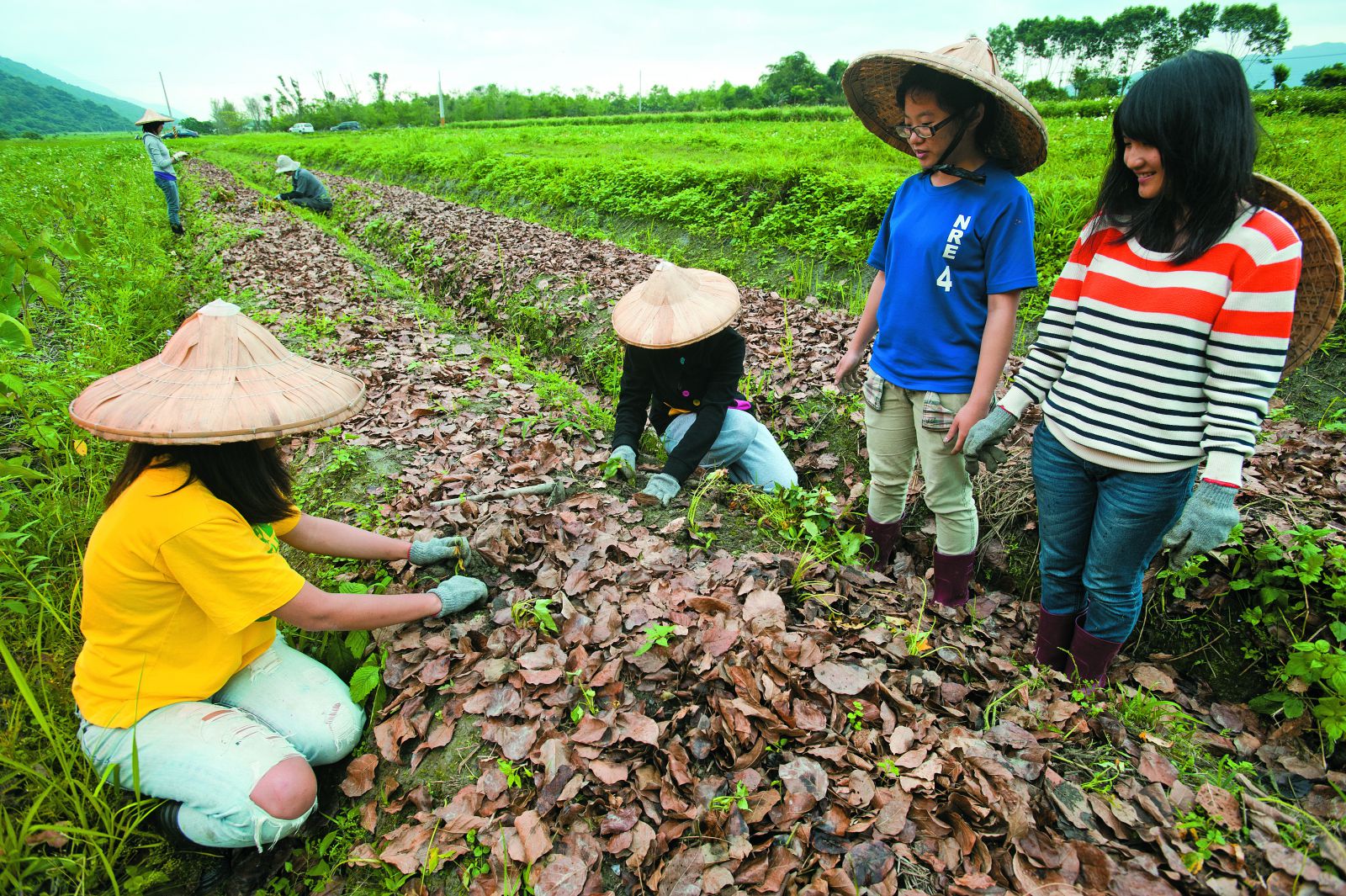

| Local and Seasonal—Community-Supported Agriculture | ||||||||||||
| By Pan Mei-ling Translated by Tang Yau-yang Used with permission of Rhythms Monthly Magazine | ||||||||||||
Planting methods reflect the underlying philosophies of farmers. Some farms are big and remote while others are small and local, and some employ chemicals whereas others use mostly natural substances to help their crops along. But whatever their approach, they all rely on consumer support for survival. If you want to be healthy, a diet rich in vegetables is a solid and convenient choice. There are many outlets where they can be purchased. On the one hand, there are large grocery stores featuring mostly mass-produced vegetables from large farms that employ chemicals to aid the growth of their crops. Let us call this class of food “mainstream produce.” On the other hand, there are small neighborhood shops that mainly sell crops from small farms nearby. We will call this “specialty produce.” Mainstream produce is much better known, simply by virtue of its wider acceptance; specialty produce is less understood among the public. Therefore, it may be useful for the reader to hear some perspectives from proponents of specialty produce.
Local characteristics Chen Hui-wen (陳惠雯) plucked snow peas in dry pods hanging from a trellis at her vegetable farm in Tamsui, northern Taiwan. Then she moved on to another section of the farm, where she pulled carrots out of the loose soil. The bunches of small carrots, despite the dirt on them, looked very nice. While I was enjoying this picturesque rural scene, Chen surprised me by saying that the best crops her farm produces are usually not destined for the kitchen. Instead, she saves them for planting in the next season. Each year Chen picks out the most viable plants for seeds. Those choice plants somehow distinguish themselves from the rest of the crops—they may be the most pungent, the most productive, or the hardiest. Her choices help ensure that she maintains a good variety of vegetables in her garden, and that variety, by extension, helps to satisfy the palate. “If our vegetable gardens are dominated only by mainstream crops, then we may as well kiss flavor diversity goodbye,” Chen claimed. “When we offer a wide range of choices and encourage the consumption of seasonal crops, we prevent the boredom that would result if we were limited to the narrow choices of mainstream vegetables.” There are 100,000 types of plants that humans have identified as edible. Out of those, about a thousand have been picked out for agricultural cultivation, with each type featuring scores or even hundreds of varieties. Therefore, it is unimaginable that our vegetable choices should be limited to the dismally few that mainstream farmers have chosen to make available to the masses. Chen grows about 130 kinds of vegetables on her farm, according to the season and the rhythm of nature. She primarily uses an approach called “Shumei Natural Agriculture.” It is a way of farming based on a deep regard for nature and respect for all living organisms. Animals and insects are recognized as having a role in relationship to crops. According to this method, nature has everything it needs in the soil. No fertilizers, nitrogen, manure, or insect and disease controls are used. Chen uses only grass and leaves for compost. Going south, we visited Li Guang-ren (李光任) at Huixiang Organic Farm in Miaoli, northern Taiwan. He has also chosen to keep his farm so that it fits in harmoniously with Mother Nature. He spent three years using the most natural—and thus slowest—method to make the predominantly clay soil on his farm more hospitable to agriculture. He stood in front of the compost area where mixtures of grass, leaves, and soil containing proper amounts of nitrogen and carbon formed one tall mound after another. Given time, about three to four months, the microorganisms in each pile will work their wonder and transform the piles into organic matter packed with nutrients that can tremendously boost the productivity of soil. Li believes that the health of the soil is the most significant factor in making organic farming a success. Li doesn’t rely on methods such as sticky insect paper or pheromone traps to ensnare or kill pests. Instead, he plants spring onions, garlic, and lemongrasses along the borders of his farm. The particularly pungent scents of these plants disrupt pests’ sense of smell, and hence their ability to find their target vegetables. This effectively forms an invisible protective shield for his plants. Li thinks that being organic is all about two things: One is to enrich biodiversity above ground, and the other is to enrich biodiversity below ground. He believes that “Only through maintaining biodiversity can human beings maintain real health.”
Mimicking nature or opposing nature? While farmers of the world like Chen Hui-wen and Li Guang-ren farm the natural way, “plant factories” opt for significantly different agricultural strategies. In fact, the two approaches to raising crops are as different as night and day. Plant factories grow their crops in human-managed environments that try to mimic Mother Nature. Naturalists like Li Guang-ren see soil as life-giving, but plant factories treat it as just another potential medium for farming, nothing more. If they can grow crops without soil, they do. We were greeted by all sorts of vegetables as we stepped into the office of a vegetable factory called Red Persimmons in Taoyuan, northern Taiwan. We saw perilla (related to mint), celery, romaine lettuce, and Ceylon spinach. The vegetables, however, were not planted in the ground as one would normally expect. Instead, they were all in pots, as if they were potted plants. They were conspicuously spotlighted with intense LED lights. We then entered a sealed, air-conditioned vegetable cultivation room, devoid of dust. Vegetables here were grown on raised beds and fed with a nutrient solution. We could not see any soil because there was none. We were looking at soilless, or hydroponic, cultivation. As a white-robed tour guide explained this cultivation method and described how chicory grew in hydroponics, a group of visitors were busy nibbling on vegetable samples. Some of them disliked their quality and taste. They thought that these vegetables were less substantial and less tasty, and they questioned if crops grown this way would be less nutritious than those grown more traditionally. “In terms of nutritional value, our vegetables may be a shade lower,” responded Zhong Tian-jing (鍾天景), general manager of the plant factory, “but you can rest assured about the safety of our products. Besides being low in nitrate and bacteria counts, they have no pest eggs, and they contain absolutely no residual agricultural chemicals or heavy metals.” Zhong also noted that since most soil is polluted these days, hydroponics is a most reasonable approach to raising crops. It can control things from the very roots so as to prevent undesirable substances from reaching the crops. So in three places, we found three approaches to growing produce—Shumei Natural Agriculture, organic farming, and hydroponics. Chen Hui-wen, Li Guang-ren, and Zhong Tian-jing each believe that they are taking a good approach, and their ways are hardly the only ones out there. Who is right? A long-time advocate for organic farming, Professor Warren Kuo (郭華仁) of the Department of Agronomy at National Taiwan University, said “Whatever organic farming method you choose, whether you are a small family farm or a huge industrial organic farm, the most crucial aspect is your intention to help keep the environment organic and healthy, and thus sustainable.”
Locals supporting locals Next we visited Hualien in eastern Taiwan, where there are close to 1,100 hectares (2,700 acres) of certified organic farms. The community of Zhixue in Shoufeng attracts a particularly large number of small organic farmers. The absence of factory pollution helps make the area ideal for organic farmers to experiment with their ideas. Wang Fu-yu (王福裕) used to want to take up organic farming in the area too, and he had even begun learning how to do it. But he soon found out that, as a local farmer put it: “In our area, we don’t need more farmers; what we need are produce sellers.” At first he thought that if he joined their ranks, he would be a welcome addition to the farmers circle, but now he knew that a better role for him would be to help farmers sell what they harvest. This made me think of what Zhong Tian-jing, of the Red Persimmons hydroponic farm, once said: He had devoted himself to the plant factory partly because of what he had seen in his father’s experience. He was a farmer who worked hard, year in and year out, but his diligence was often repaid with incommensurate and unjust rewards. His hard work could not guarantee a steady income for the family because harvests were often heavily influenced by weather. Other farmers were in the same predicament. Zhong remembered seeing for-sale signs on tracts all around his home town, as farmers put their land on the market. He remembered how severely those sights hurt him. “Back in the old days, selling your land was terribly shameful.” He knew that they were forced to sell, and he wanted to break free from the terrible bond that tied harvests to weather. Seasonal fluctuations in production and price often put farmers’ incomes on rollercoaster rides. “Winter [in Taiwan] is a good time to grow vegetables, but high outputs depress the prices,” said Chen Bi-lang (陳碧郎), a farmer in Taoyuan. “In summer, on the other hand, typhoons, along with heat, humidity and hence pests, often cause vegetable shortages.”
Fluctuations in produce outputs and management of supply channels to consumers are indeed common problems facing farmers. They want to find buyers for their produce when it is still in peak condition, and buyers want to pay reasonable prices for quality goods. Prone to rot, vegetables, especially leafy varieties, must be harvested and sold in very small windows of time. Most farmers concentrate their efforts on planting alone and are therefore often exploited by middlemen, who shamelessly pay little to farmers but charge consumers exorbitant prices. Middlemen, those who have the least to do with agriculture, make the highest profits while farmers, those without whose effort vegetables cannot be produced, suffer the most loss. Wang Fu-yu chose to be a different kind of a middleman. He founded Big Wang Vegetable Shop in 2008. The business buys vegetables from local farmers, takes orders from online buyers, and ships the orders to them. Large companies do not buy small lots, like three or five kilograms (7 to 11 pounds), from farmers, but Big Wang does. The shop pools the harvests of small local farmers into larger lots and arranges how best to sell them. It has a website where it updates products and availability and fills orders. It takes much of the uncertainty of selling the vegetables out of the hands of small farmers so they can concentrate on what they do best: farming. When weather affects farmers’ harvests and Big Wang cannot fill a customer’s order, a staff member explains the situation and appeals to the customer to buy other vegetables instead. “We can’t be rigid like big companies,” said Wang. “Most importantly, we’ve established a bond with both producers and consumers. This bond is built on mutual understanding and trust.” Wang believes that consumers are the ones that most need to change to make a distribution system like his work well. Consumers can most seriously damage the system when they are critically fussy about the outward appearance of the vegetables that they buy, or when they demand unreasonably low prices. In this regard, Wang sides with the farmers. He tells his buying clients who seek low prices, “These are the [good] vegetables that you want, so these are the [fair] prices that are required.” Big Wang’s first concern is for the farmers. This approach of handling customers is typically shunned by traditional mainstream businesses. Big Wang can survive in this untraditional niche largely because of the support of their customers. This bunch of consumers is willing to support another bunch of idealistic farmers trying to grow wholesome vegetables for people who care about their food. This is CSA—community supported agriculture—at work. Wang and other participants in this CSA circle are aware that vegetable cultivation is no small matter, and they have built a conduit through which consumers and producers may have more direct connections.
CSA One day Wang Fu-yu, nicknamed Big Wang, drove around Hualien in his small truck, delivering vegetables that people had ordered. At the Rainbow Field Bakery, one of the pickup spots for his buyers, we met Zhang Zhi-hong (張志宏). Zhang subscribed to Big Wang’s service in hopes of giving his wife, who was expecting a baby, nutritious food. He said that since he subscribed, he has become more mindful of the food they eat and has come to appreciate the real taste of farm-fresh produce. Another subscriber who was there to pick up her order told me that she used to shop at organic food stores, but she had noticed that they offered only limited choices. She had therefore known little about vegetables outside of what had been available to her at these stores. That started to change when she switched to Big Wang two years ago. She has learned much more about veggies from the variety that Big Wang offers each week. Each plant has its growing season, so it is natural for vegetables to go out of season. The expectation of having a particular vegetable available all year round goes against the way of nature. The practice can be sustained only by artificial means, such as heavy doses of man-made fertilizers and pesticides—things that naturalists like Wang avoid. “We offer only what grows naturally in the field, so our customers can’t be picky. They eat only seasonal food,” said Wang. Hideo Kawana, a Japanese agriculture writer who advocates natural planting, once said, “What we eat determines how we live our lives.” The method with which vegetables are cultivated directly impacts our health, and it even alters the face of the earth. Support good farmers and support good food. You and I can become the force to change the world.
|














|

